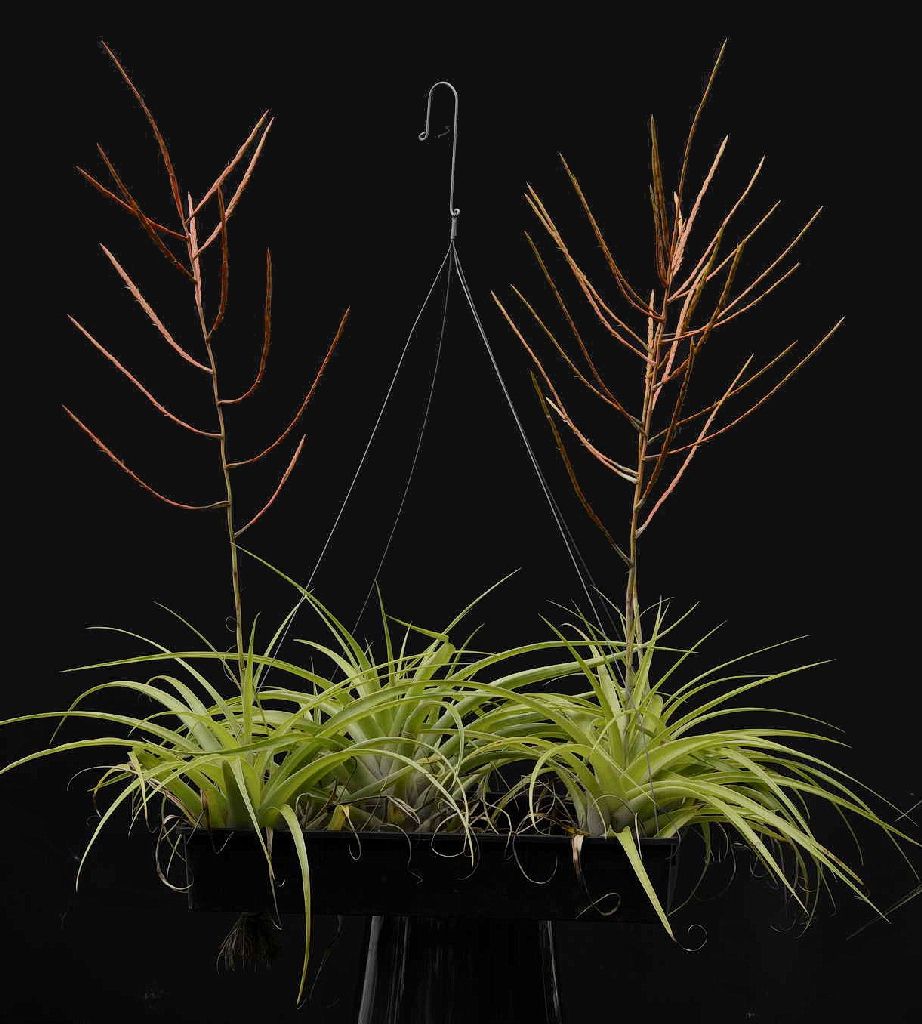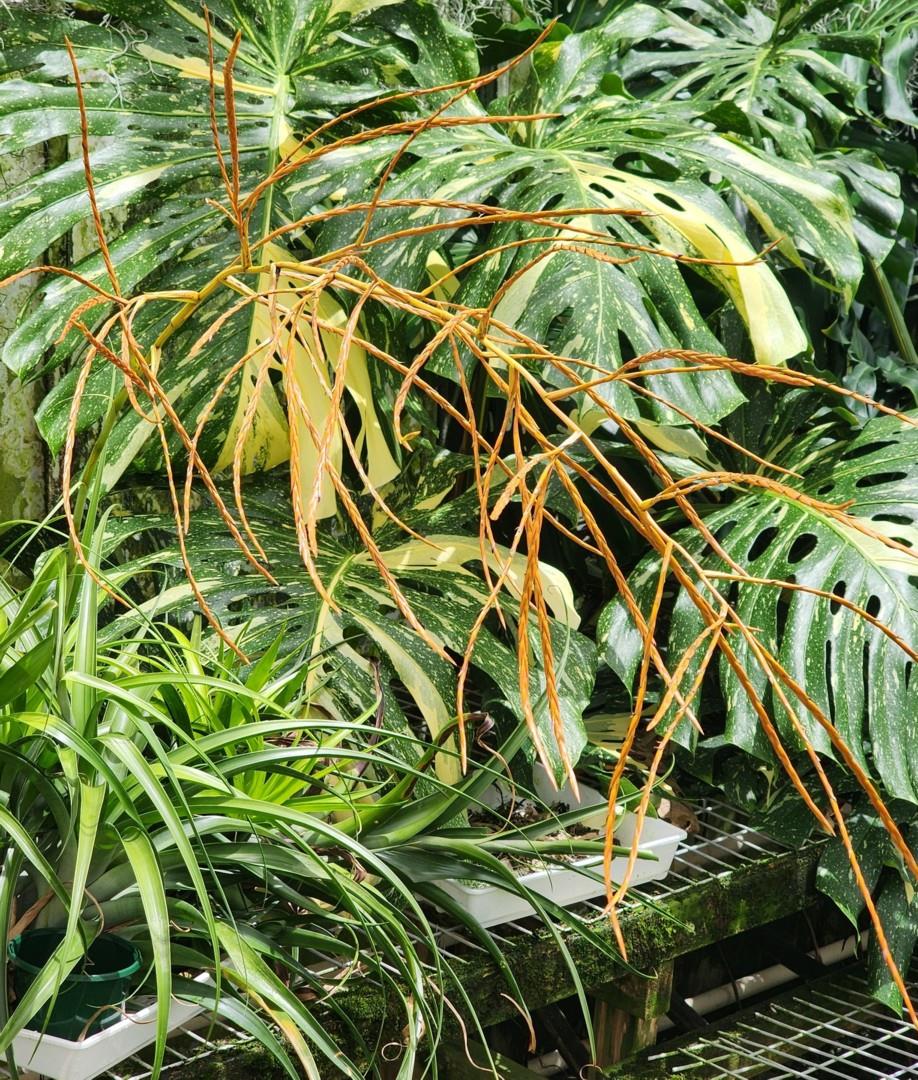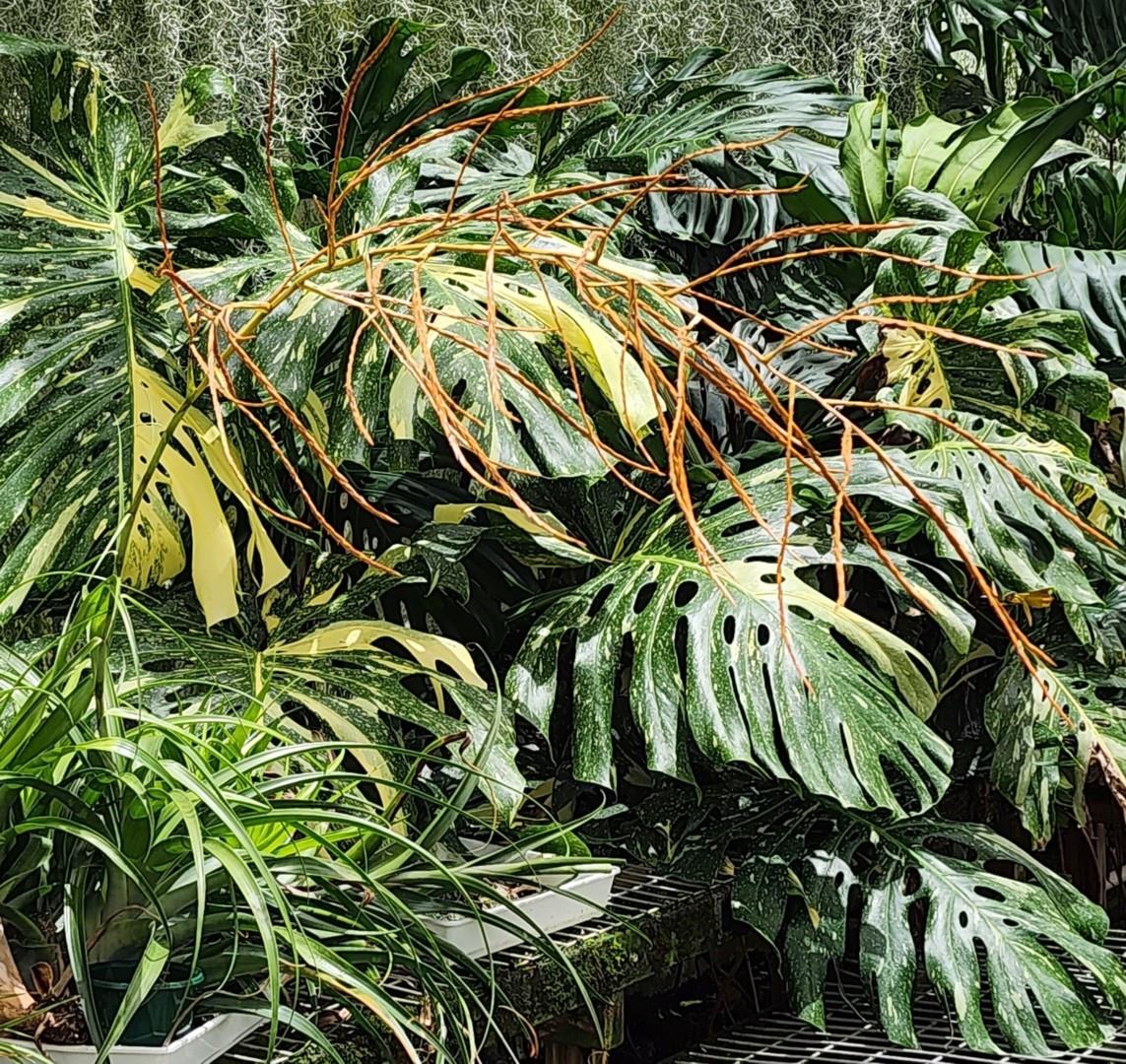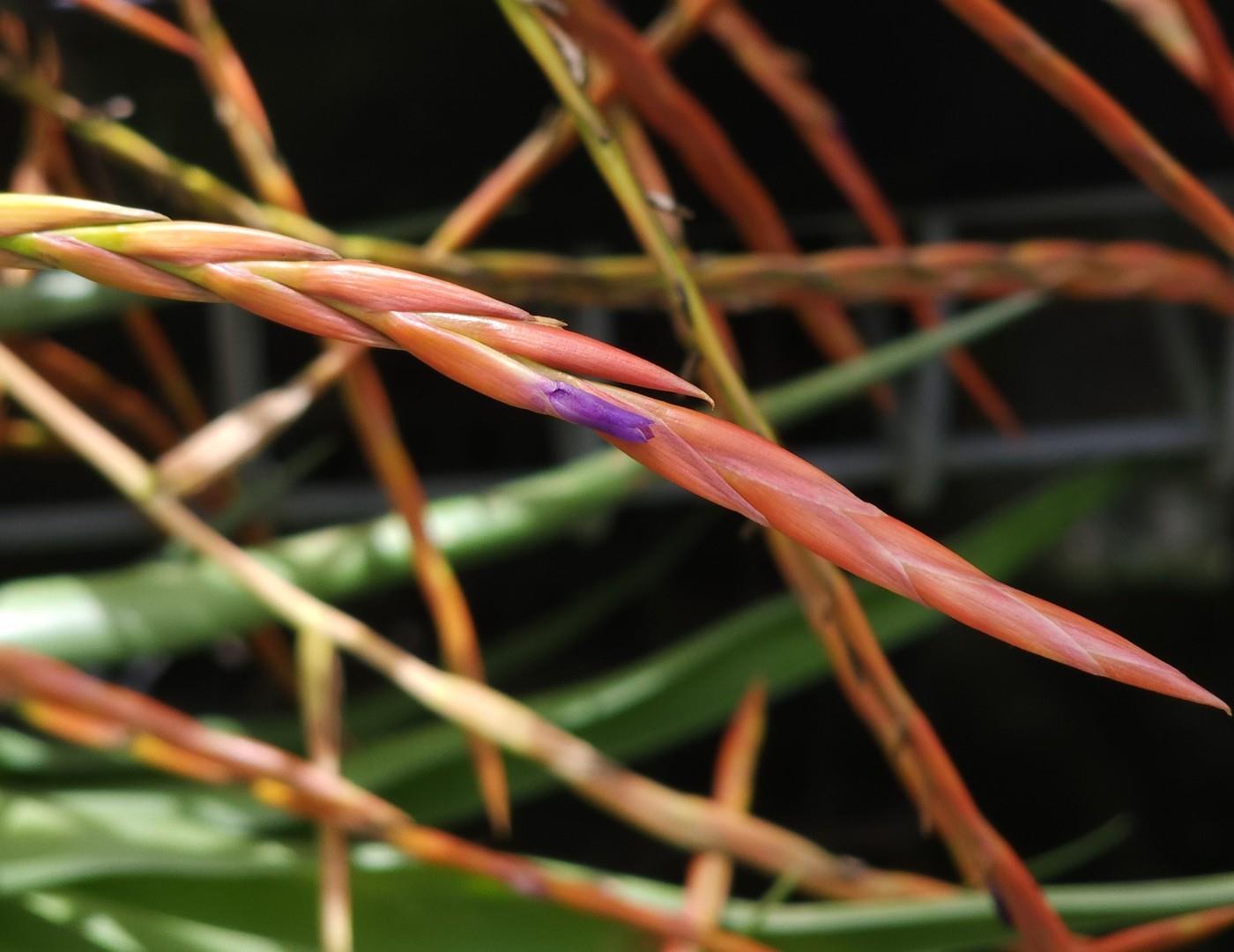











Chris Larson ... "I can't see T. elongata in this one. Not sure what Harry was basing his decision on. Peter Tristram, Bruce Dunstan ? You'd have to use the keys."
Ian Cook ... "I'll repost this here once a flower actually pops then. We have a mystery."
Bruce Dunstan ... "Reminds me of what Derek named 'Chalky White'."
Ian Cook ... "My plant's inflo will not be as complex as pics from Bruce Dunstan's above. ....unless of course it has still a lot of growing to do... been forming this spike for some weeks now. I agree, there is a problem, and will confirm once I see a flower."
Peter Tristram ... "Yep, looks like Chalky White, aka T. calcicola."
Chris Larson ... "These were the seedlings I was growing as T. elongata var subimbricata which were much larger than the T. Chalky White. Maybe this one got mixed up.
Ian Cook, is the foliage bigger than 40cm? Chalky White for me flowers between 25cm & 35cm cm to the top of the foliage I reckon. I havent had it bigger than 40cm."
Peter Tristram ... "Chris, T. Chalky White can get bigger here. I've got one in bloom, I think, so I'll investigate. I still think T. calcicola is correct, as the Germans also call it, so I discovered."
Ian Cook ... "30cmm base to growing tip (before flowering) 50cm span tip to tip across."
Chris Larson ... "At that size it is 'Chalky White'. Plenty on 'Bromeliads in Australia' about it. Some think its a T. calcicola - some don't.
I was thinking it bigger - my foliage looks slightly whiter and a tighter rosette. But no reason to think its anything other than culture.
T. Chalky White is easier to grow down south than most of the utriculatas. Most importantly - I would have had T. Chalky White to mix it up with."
Ray Clark ... "Looks like I have another plant to relabel based on this conversation, I probably got mine from Chris Larson about that same time as Ian."
Tillandsia elongata var elongata
Spikes to 4 dm long and 40-flowered.
TYPE. Humboldt & Bonpland 1703 (holotype B, F photo 11492), Honda, Rio Magdalena, Tolima, Colombia, Sep 1801.
DISTRIBUTION. Epiphytic in moist or dry open woods, 300-1050 m alt, Colombia. COLOMBIA. MAGDALENA: Fundacion, Sierra Nevada de Santa Marta, 29 Aug 1946, Foster 1621 (COL, GH, intermediate form).
CUNDINAMARCA: Apulo, 4 May 1944, Killip, Dugand & Jaramillo 38150 (US); Giradot, 13 Oct 1946, Foster 1892 (GH, US). TOLIMA: Rio Icononzo, 13 Oct 1946, Foster 1888 (GH). VALLE: Zarzal, 21 Jul 1922, Pennell, Killip & Hazen 8396 (GH, NY, PH, US); Espinal, Dagua, Sep 1922, Killip & Hazen 11097 (GH); Cali, 31 Mar 1939, Killip & Varela 34696 (COL, GH, US); Apr 1960, DeLeon 398 (US); Zarzal, near Bugalagrande, 20 Jul 1939, Perez-Arbeldez & Cuatrecasas 6403 (COL); 7 Oct 1946, Cuatrecasas 22105 (F, GH); Cartago, Santa Ana de los Caballeros, 19 Nov 1946, Cuatrecasas 23044 (F, GH); Palmira, 3 Dec 1947, Ramirez, Murgueitio & Barkley 17-C-880 (COL); 17 -C-882 (US); Lobo Guerrero, 28 Aug 1968, Espinal & Ramos 2500 (US, VALLE).
Tillandsia elongata Kunth in H. B. K., Nov. Gen. & Sp. 1: 293. 1816. var. subimbricata (Baker) L. B. Smith, J. Wash. Acad. Sci. 43: 68. 1953.
Tillandsia subimbricata Baker, London J. Bot. 25: 304. 1887.
Type: Trinidad, without locality, Fendler 816 (holotype K).
Description from Flora of the Guianas by E Gouda 1987
Plant acaulescent, flowering 55 cm to over 150 cm, with a spreading or crateriform, mostly ca. 40 cm or taller, rosette of about 25 light-green leaves.
Leaves coriaceous, 30-60 cm long, much exceeded by the inflorescence;
Sheaths ample, contracted into the blade, elliptic, 5-13 x 3.5-8 cm, with narrow paler and chartaceous margins, (sub-) densely appressed-lepidote with white and darker centered scales, soon sparsely brown punctulate-lepidote toward the base inside, pale-brown to castaneous at the base and often suffused with dark-purple inside;
Blade arching and often recurved, very narrowly triangular, 18-46 x 1.7-4 cm, often involute at the margins when dry, filiform attenuate, (sub-) densely appressed-lepidote but soon less so or glabrescent at the upperside.
Inflorescence sublaxly bi- to quadripinnate of 3 to many branches, 15-50(?) cm long;
Scape erect, 5-11 mm in diam., 0.3 to over 1m long, glabrous, densely covered by bracts, but sometimes the bracts so narrow to expose the scape in part;
Scape bracts mostly densely imbricate, the lower ones with foliaceous blade, the upper ones ovate-lanceolate, with filiform blade to apiculate, excluding the blade to twice as long as the internodes, sub densely lepidote to glabrescent; axis exposed, at least in upper part, straight, terete, glabrous, mostly reddish;
primary bracts as the upper scape bracts, or the upper ones as the floral bracts, spreading with the branches;
Spikes spreading, subsessile or with short bracteate peduncle, linear (-lanceolate), complanate, 5-18 x 0,7-1 cm, acute, densely and distichously 7-25-flowered, with one sterile bract at the apex; rachis partly exposed at the base of the bracts (if at all), slender, nearly straight, angled, glabrous;
Floral bracts contiguous or subspreading toward the apex when dry, imbricate, thin-coriaceous, with even surface, but strongly veined when dry, ovate (-oblong), 1.8-2 cm long, about twice as long as the internodes, much exceeding the sepals, fleshy in the middle and chartaceous at the margins, incurved at the extreme apex, apiculate, ecarinate, glabrescent or sparsely lepidote toward the apex, minutely brown-lepidote inside.
Flowers erect, subsessile; receptacle obconic, bicarinate, including pedicel ca. 3 mm long;
Sepals coriaceous, with even surface, ovate-oblong, 1.1-1.3 cm long, with broad thin hyaline margins, broadly rounded, free, the posterior ones very fleshy and angled in the middle near the base, sparsely and minutely brownlepidote only inside, red or yellowish and rose;
Petals thin, ligulate, ca. 1.7 cm long, violet in upper part;
Stamens just exceeded by the petals but exceeding the pistil(?), filaments thin, straight, flat, anthers basifixed, sagittate, ca. 4 mm long, free lobes less than 1 mm long, bidentate at the apex;
Ovary slenderly ovoid, ca. 4.5 mm long, contracted into the slender style, stigmas linear.
Capsules cylindric, ca. 3.5 cm long and 3 mm in diam., attenuate from near the base to the apex, then abruptly subacute.
Distribution : Mexico and Jamaica to Peru and N. Brazil. Terrestrial or epiphytic in thickets and forest, 15-1200 m alt. 6 collections studied. This species is occasional on upper slopes of Cerro Toribio, E. Bolivar, Venezuela and has been recorded for the Rio Branco area, Isla do Ajarani, Roraima, Brazil. It may be expected in Guyana.
Information from S&D p773
Tillandsia elongata var subimbricata (Baker) L. B. Smith, Jour. Wash. Acad. 43: 68. 1953.
Tillandsia subimbricata Baker, Jour. Bot. London 25: 304. 1887.
Tillandsia orthorhachis Mez & C. F. Baker, Bull. Torrey Club 30: 435. 1903. Type. Realejo, Chinandega, Nicaragua, C. F. Baker 2092 (B).
Spikes only about 2dm long and 20 flowered.
Distribution Terrestrial or epiphytic in thickets and forest, 15-450 m alt, Mexico and Jamaica to Peru and northern Brazil. MEXICO. YUCATAN: Merida, 28 Jul 1865, Schott 556 (F); Chichen Itza, 1938, Lundell 7558 (F); without exact locality, Schott 810 (BM). NICARAGUA. MATAGALPA: San Ramon to Bavaria Finca, 1963, Heller 5972 (F, US). CHONTALES: Acoyapa, 4 Jan 1969, Atulood 1652 (US). PANAMA. COLON: Gamboa, Rio Chagres, Allen 4152 (MO, US). PANAMA: Punta Paitilla, 7 Dec 1923, Standlev 26254 (US); Panama, 13 Dec 1923, Standley 26837 (US); 20 Aug 1962, King 5338 (US); Rio Tapia, 1924, Standley 28255 (US). DARIEN: Rio Sabana, Santa Fe, Apr 1954, Herb. Leopold III no.234 (BR). JAMAICA. TRELAWNY: Windsor Estate, 27 Aug 1955, Proctor 10627 (IJ, US). ST. ELIZABETH: Mountainside, 12 Aug 1954, Proctor 9254 (IJ). HANOVER:Jericho, 29 Sep 1957, Proctor 16697 (IJ, US). COLOMBIA. MAGDALENA: Chiriguana, Magdalena Valley, 25 Jul 1924, Allen 161 (MO). BOLIVAR: Arjona, 15 Nov 1926, Killip & Smith 14530 (GH, US). CALDAS: Granja cafetera de Chinchina, Mar 1947, Duque-Jaramillo 4670 (COL). VENEZUELA. NUEVA Esre PARTA: Macanao, Dec 1951, Gines 2847 (US). SUCRE: La Toma, Cumana, 21 May 1945, Steyermark 62867 (F, GH). MIRANDA: Ocumare del Tuy, 30 Jul 1949,Martinez 18 (VEN); Curupao, Guarenas, I Jun 1963, Steyermark & Farinas 91489 (US, VEN). DISTRITO FEDERAL: El Carenero,Jun 1943, Cardona 561 (VEN). ARAGUA: Cansa Macho, 17 Oct 1951, Foster 2764 (US, VEN). ZULIA: Mision de Los Angeles de Tokuku, Machiques, 29 Aug 1967, Steyermark 99850 (US, VEN). T ACHIRA: Ayari, 27 Aug 1966, Steyermark & Rabe 96661 (US, VEN). BARINAS: El Canton, Steyermark, Bunting & Blanco 101960 (VEN). BOLIVAR: Cerro Torribio, 22 Oct 1953, Maguire, Wurdack & Bunting 35936 (NY). TRINIDAD. Marabella, Herb. Trin. 2007 (TRIN); Wellington Estate, Herb. Trin. 773; Moruga, Broadway s n (NY, TRIN 7600); Caroni, Broadway s n (TRIN 10231 ); 1944, Pittendrigh 1065 (US); St. Ann's, Aitken 284 (TRIN); Broadway 7463 (GH, S); River Estate, Diego Martin, Simmonds 210 (TRIN); San Fernando, Howard 10392 (TRIN); Point Fortin, Downs 26 (TRIN); Tabaquite, Aitken 96 (TRIN); Oropuche, 25 Mar 1959, Cowan & Forster 1256 (US). PERU. LORETO, Alto Amazonas: Sanango, Yurimaguas, 12 Sep 1948, Ferreyra 4906 (USM). BRAZIL. RIO BRANCO: Isla do Ajorani, Kuhlmann 391 (RB).
Protologue
Tillandsia orthorhachis Mez & C. F. Baker, Bull. Torrey Club 30: 435. 1903
Foliis utrinque lepidibus pallidis adpressis obtectis praesertim subtus cinerascentibus, persensim acutis; inflorescentia paupere panniculata e spicis ±6 laxiusculis, pinnatis composita; bracteis florigeris stricte erectis, haud vel vix imbricatis, axes omnino rcctos haud obtegentibus, dorso glabris et manifete venoso-lineatis, apice acutiusculis, scpala longe superantibus; floribus stricte erectis; sepalis subaequaliter liberis.
Acaulis, florifera metralis, Folia utriculatim rosulata, basi in vaginas magnas, ovales, dense lepidibus inferioribus immersis, centro late brunneis margine pallidis consitas dilatata, ±0.35 m. longa, super vaginas ad 25 mm. lata, inde in apicem eleganter recurvum, crasse subuliformem persensim angustata elongatissime subtriangularia,.sicca rigida. Scapus folia longe superans, validus erectusque, dense vaginis inferioribus in laminas subulatas recurvas desinentibus superioribus haud laminigeris apicc acutis, erectis adpressique, internodia superantibus involutus. Infloresccntia submultiflora, laxe 2-pinnatim e spicis sat elongatis, linearibus, usque ad 140 mm. longis, basi prophylla compluria bracteiformia gcrcntibus composita, folia perlonge superans, ± 250mm. longa; spicis 8-14-floris, suberecto-erectis, axibus nullo modo undulatis vel geniculatis, valde angulatis, glabris; bracteis primariis omnino vaginis superioribus scapalibus isomorphis, quam spicae permulto brevioribus, ramuli axillaris basin haud involventibus; bracteis florigeris ±15 mm. distantibus, praeter marginem anguste membranaceum coriaceis, nullo modo carinatis, explanatis anguste ellipticis, intus glabris, ±20 mm. longis et 7 mm. latis. Flores stricte erecti, rhachi adpressi, pedicellis brevibus (vix 3 mm.) angulatis stipitati; sepalis 12 mm. longis, anguste cllipticis, apicc rotundatis, glabris, prominulo-venosis, subcoriaceis. Capsula ad 35 mm. longa, sub-cylindrica angulis 3 rotundatis, bene acuta.
Nicaragua, dept. Chinandega, prope Realejo, arboribus epiphyta : C. F. Baker, no. 2092.- Fructificat Januario.
Obs. - Species perinsignis, absque dubio Tillandsiae adpressiflorae Mez Guyanensi characteribus proxima, habitu magis ad T. utriculatam L. accedens, ab omnibus affinibus spicarum rhachibus rectis sat diversa.